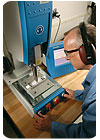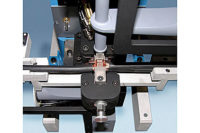
When baking a batch of cookies, the end result often depends on what shape the dough is in when you close the oven door. While ultrasonic welders are far more advanced than cookie cutters, the same basic logic applies when joining injection-molded parts: If poor designs go in, there’s a good chance that the components that come out will be disappointing.
Ultrasonic welding is a cost-effective, widely used process for assembling plastic automotive parts, consumer goods and medical devices. It is a fast joining process that’s easily suitable to high-volume production. Ultrasonic welds are also relatively free of flash.
However, joint design and location are very important in ultrasonic welding, as is good dimensional control of the parts. Without good part design, manufacturing engineers may end up with numerous headaches.
“The basic requirement for success in any plastic welding application is to have a uniform initial contact area between the two parts,” explains Steve Woida, applications engineer at Forward Technology Industries Inc. (Cokata, MN). “The size and shape of these two joining surfaces is extremely important to the success of the weld.” Consistent molding practices are also critical to successful ultrasonic welding.
“In the majority of cases, high quality parts are a must,” says Marc St. John, senior engineer for plastic welding at the Edison Welding Institute (Columbus, OH). “Ultrasonic welding is a sensitive process, with a relatively small processing window. It cannot tolerate deficiencies such as dimensional variations, which are common in multicavity molded parts, or parts from poorly filled mold cavities.”
“Poorly designed or molded parts can make or break the welding process,” warns Ken Holt, applications manager at Herrmann Ultrasonics Inc. (Schaumburg, IL). “Both design and molding have to be well executed for the optimal output of the process.”
Otherwise, you may end up with parts that leak, parts that have low weld strength, or parts that are too big or too small to fit into another component. “[Typical problems include] dimensional mismatch, cosmetic rejects and bad performance,” says Chung-Yuan Wu, Ph.D., plastic welding technical fellow at Visteon Corp. (Van Buren Township, MI) and chairman of the SPE Plastics and Composites Joining Special Interest Group (Brookfield, CT). “Poor parts cause inconsistent welding and joint quality that leads to high scrap rates and rejects.”
Sometimes, problems aren’t related to the shape of the parts, but to how well they are made. According to one expert, many parts molded in Asia are “not even close to being of the quality that U.S. molders produce.” He says you can almost tell the origin of the parts just by looking at them.
Initial sampling can show deficiencies in the design. However, subsequent molding runs must be held constant enough to produce the same parts to keep the ultrasonic process working well.
“This frequently occurs when molds are moved from molder to molder for piece-part price considerations,” explains Holt. “To [produce] parts that are cheaper, shortcuts are frequently made to the molding process, such as shorter cycle times, which can adversely affect the quality of the parts.”
While poor parts create ultrasonic welding problems, some issues can be addressed. For instance, closed loop controls help eliminate some of the traditional inconsistencies in weld quality.
Unfortunately, some engineers try to use ultrasonic welding “as a sort of steamroller for variations coming into it from other processes,” notes Tom Kirkland, president of Tributek (Elburn, IL). “Often, the specifications are built around final appearance and function, but not weldability.”
For example, he says material may be specified from more than one supplier or with the infamous “or equivalent” tag, which many purchasing agents and suppliers love to see. “That can cause severe problems, depending on the robustness of the process,” Kirkland points out.
“Too many times, we are asked to provide welders and tooling as Band-Aids to correct poor design issues,” adds Robert Bishop, president of Sonitek Corp. (Milford, CT), “especially snap-fit designs that don’t work.”
The Usual Suspects
Poor parts can be caused by several different factors. Leading culprits include incompatible thermoplastic materials or resin grades, incorrect joint design, dimensional variations from part to part, inadequate fixturing, and insufficient designer knowledge.Traditionally, incorrect injection-molding process parameters, such as time and temperature, have been a leading cause of problems. However, equipment vendors have improved reliability and eliminated most of the risk of making major processing errors.
“The injection molding process has come a long way in the last decade,” notes Jeff Frantz, director of applications and acoustics engineering at Branson Ultrasonics Corp. (Danbury, CT). “The parts are more consistent and there seems to be less variation.”
“We seldom we see poor parts today,” adds Bishop. “It’s hardly ever the molding process. Injection molding machines, mold flow analysis and finite element analysis have really knocked poor molded parts for a loop. It’s inadequate designs that we see more commonly, but nowhere like we used to. I really think designers have gotten much smarter, or maybe it’s just the software [that they’re using].”
According to Jordan Rotheiser, president of Rotheiser Design Inc. (Highland Park, IL), injection molding is not rocket science. He says there are few problems with the process, “unless the molder has raised the melt temperature too high in order to speed up the cycle. That can lead to uneven part surfaces, sink marks, warpage, and poor dimensional stability, even in a well-designed part.
“When I get called in on problem projects, the cause is usually incorrect engineering design or material selection,” claims Rotheiser, who is the author of Joining of Plastics (Hanser Gardner Publications, Cincinnati). “The next most common cause of poor parts is incorrect molding parameters that result from attempts to lower costs.”
Kirkland agrees that cost pressures can create unforeseen problems. He calls it the optimism-reality intersection. “Optimism runs high during product introduction, when part quality is often, in relative terms, under a microscope,” he explains. “Cost pressures driving material specification changes or process setting changes upstream-and simple lack of attention to detail-later on will tend to expose the excessive optimism of the early days, just when you think all of the issues are put to bed.”
Lack of communication also leads to problems with plastic parts. “That often happens when injection molding process changes occur without informing the right people downstream,” says Brian Gourley, technical services manager at Sonics & Materials Inc. (Newtown, CT). Problems also occur when purchasing people change raw material suppliers without much warning or without any testing prior to use.
Sonitek’s Bishop claims that too many part designers simply fail to communicate with manufacturing engineers. “They fail to communicate with the experts about feasibility,” he points out. “This is a cardinal sin in my opinion, because all of the companies in the plastic joining field provide so much data on our Web sites and in print to assist with the process. Plus, phones still work.”
“Sometimes, you can see some of these things coming, and other times they just jump up when somebody decides later to try to ‘improve’ things without telling anybody,” adds Tributek’s Kirkland. “Just changing the boost pressure on the molding machine can cause assembly processes to fall out of bed down the line.”
Material compatibility is also an important factor to consider. However, most experts generally don’t recommend welding parts that are not made of exactly the same materials or grades. “Most of the time, you cannot weld dissimilar materials,” warns Bishop. For instance, dimensional stability due to different cooling rates may cause problems. Thin, unsupported walls can bow and cause havoc, too.
“Incompatible plastics would be an issue that can only be solved by changing material,” says Janet Devine, president of Sonobond Ultrasonics (West Chester, PA). She strongly recommends checking with resin suppliers and ultrasonic welding equipment vendors before finalizing any design that you intend to use.
Devine says there has been a gradual increase in knowledge about the more scientific approach of initial feasibility studies. For instance, charts for compatibility are readily available and are updated regularly.
Common Pitfalls
Uneven part surfaces, sink marks, warpage and poor dimensional stability are some of the most common pitfalls associated with injection-molded parts. They can all inhibit the ultrasonic welding process.Uneven part surfaces and sink marks form as a result of insufficient shot size. They also occur as a result of a larger wall thickness in areas of the part shrinking more locally than a surrounding thin wall area.
Warpage is a condition where a feature is not in an intended shape, such as a flat ledge curving upward at its ends, or a wall bowing inward instead of being straight.
Poor dimensional stability results in parts fitting together differently, or into the ultrasonic tooling differently, from run to run, batch to batch, or cavity to cavity.
“All of these deficiencies can be especially problematic if their presence adversely affects the intended welding design and interface,” says Herrmann Ultrasonics’ Holt. “Warpage and poor dimensional stability can play havoc on weld joints; particularly shear joint type designs, as it can make the intended interference larger or smaller than intended. This can create a host of problems in welding consistency.
“Also, if the sink marks or warpage occur on the horn or sonotrode contact surface, the uneven pressure exerted on this surface can create marking,” Holt points out. “This can be especially detrimental if [the part must have a surface with a good appearance].”
Visteon’s Wu says sharp corners and hangover tabs are some other common pitfalls that engineers should watch out for. “The distance between the joint interface and sonic horn should be kept as short as possible,” he suggests. “Long distances require higher sonic energy to weld. That can lead to [inconsistent] heating in the part and surface marking.
“Diaphragmming is also a common pitfall that results in overheating the part,” adds Wu. “Reinforced ribs should be considered in the design. Holes and voids between the joint interface and horn should be avoided.”
Shape and geometry affect the overall quality of ultrasonic joints. There are two major types of joint design, says Branson’s Devine: the energy director and the shear joint.
The energy director is typically a raised triangular bead of material molded on one of the joint surfaces. Its primary function is to concentrate the energy to rapidly initiate the softening and melting of the joining surfaces. Devine says the energy director is the most commonly used design for amorphous materials.
The ideal situation is a uniform joint in a single plane over the whole proposed joint, but this is not always possible. According to Sonitek’s Bishop, if a part is very complex in shape, then the horn will be very difficult to contour and tune, thus minimizing the part’s inherent ability to transfer mechanical energy to the joint.
“The most common pitfall is the 90-degree angle, or any sharp corner molded without radii,” says Bishop. “Ultrasonics has an uncanny ability to find and show stress risers, and these sharp corners will always crack. In addition, thick-to-thin wall transitions and unsupported protrusions can shake-off during welding.
“If the joint is too far away, is a semicrystalline material and is complex in shape, [you’ll need more than] good luck,” concludes Bishop. “Be prepared to buy hot-plate welders, vibration welders or laser welders. These are expensive systems with very long lead times and limited uses as alternatives to ultrasonics. [To minimize part design problems] it’s important to do your research and consult with experts.”

